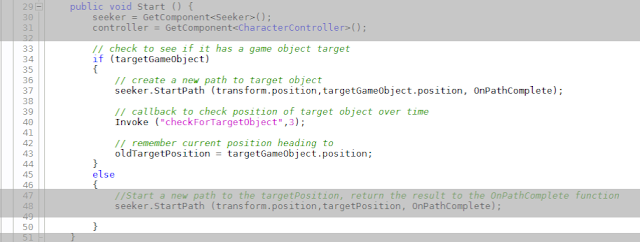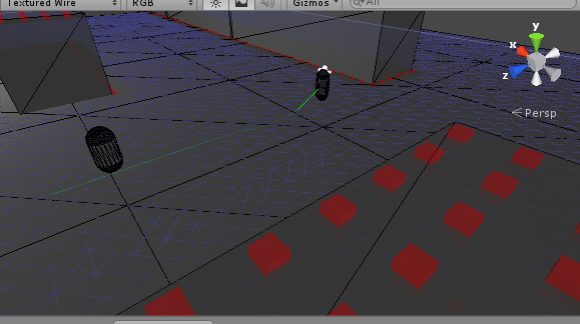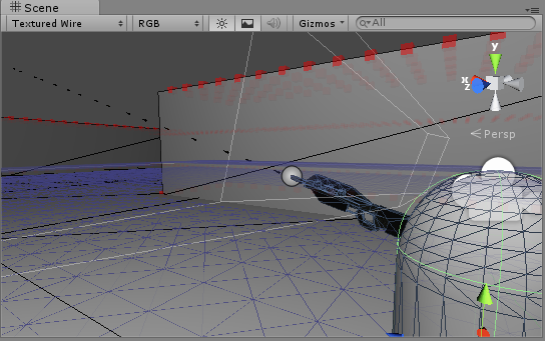Saw this on good game and thought it would be good for the Animation and Games students
http://www.abc.net.au/tv/goodgame/stories/s3784334.htm
Tuesday, July 23, 2013
Monday, July 22, 2013
Unity Links I just found that are of use
2D games in Unity
http://www.rocket5studios.com/tutorials/make-a-2d-game-in-unity3d-using-only-free-tools-part-1/
300+ tutorials on making a Hack'n Slash in Unity
http://www.burgzergarcade.com/hack-slash-rpg-unity3d-game-engine-tutorial
Using Texture Packer with Unity + misc. tutorials
http://www.codeandweb.com/texturepacker/start-download?os=win32#unity
http://www.rocket5studios.com/tutorials/make-a-2d-game-in-unity3d-using-only-free-tools-part-1/
300+ tutorials on making a Hack'n Slash in Unity
http://www.burgzergarcade.com/hack-slash-rpg-unity3d-game-engine-tutorial
Using Texture Packer with Unity + misc. tutorials
http://www.codeandweb.com/texturepacker/start-download?os=win32#unity
Flat out on 2D
| ||
If you’re making or considering 2D games in Unity take a look at Unity Evangelist Brett Bibby’s handy workflow tutorials.They take you through the process of authoring 2D content in Photoshop, exporting it and importing that content into Unity. All the files you need to complete the tutorials are available here.
| ||
Sunday, April 21, 2013
Unity Research
1 hour
Reading through articles on the net, checking out FPS Control and reviewing plugins with a view to build some tutorials for student for next semester when we launch into their massive 3rd person 3d game.
Stealth: (framework for Artificial Intelligence / enemies can track you if they see you - but you can outwit them by running away and hiding - Free)
http://unity3d.com/learn/tutorials/projects/stealth
FPS Control (framework to build first person shooter - free)
http://www.fpscontrol.com/?aff=assetstore
Probuilder: Seemless level building tool - $95
It's like Hammer, CartStudio and 3dWorldStudio - a constructive solid geometry editor to allow users to build their scenes directly in Unity, with the ability to clone, model, light, bake shadows and texture.
http://www.probuilder3d.com
Mega-fiers
Various toolsets including morphing, terrain creation, lofting objects (racing, fences, roads and tank tracks) and scatter (easy environment object randomisation - trees, rocks etc)
http://www.west-racing.com/
Reading through articles on the net, checking out FPS Control and reviewing plugins with a view to build some tutorials for student for next semester when we launch into their massive 3rd person 3d game.
Stealth: (framework for Artificial Intelligence / enemies can track you if they see you - but you can outwit them by running away and hiding - Free)
http://unity3d.com/learn/tutorials/projects/stealth
FPS Control (framework to build first person shooter - free)
http://www.fpscontrol.com/?aff=assetstore
Probuilder: Seemless level building tool - $95
It's like Hammer, CartStudio and 3dWorldStudio - a constructive solid geometry editor to allow users to build their scenes directly in Unity, with the ability to clone, model, light, bake shadows and texture.
http://www.probuilder3d.com
Mega-fiers
Various toolsets including morphing, terrain creation, lofting objects (racing, fences, roads and tank tracks) and scatter (easy environment object randomisation - trees, rocks etc)
http://www.west-racing.com/
Friday, April 19, 2013
Unity research
3 hours.
While I have a free few hours I'm reading a new book called "Creating Games With Unity and Maya", for the sake of covering some new ground in scripting and state management to help the students make their games more marketable.
I'm going through GUI, Object instantiation, inventory systems, winning/losing the game and then triggers and ray casting so the students will have a good grasp on interacting with their environment.
Update 21st April : added GUI hint triggers so as player moves through scene they get hints come up at the bottom of the screen explaining what to do next. Also converted the code in the book from JavaScript to C# as that's what the students need to learn right now. Finally the hints are attached to scene objects using triggers so as the player moves through the triggers the hints come up. I need to implement a flag so that the hints don't come up again once th eplayer has seen them.
While I have a free few hours I'm reading a new book called "Creating Games With Unity and Maya", for the sake of covering some new ground in scripting and state management to help the students make their games more marketable.
I'm going through GUI, Object instantiation, inventory systems, winning/losing the game and then triggers and ray casting so the students will have a good grasp on interacting with their environment.
Update 21st April : added GUI hint triggers so as player moves through scene they get hints come up at the bottom of the screen explaining what to do next. Also converted the code in the book from JavaScript to C# as that's what the students need to learn right now. Finally the hints are attached to scene objects using triggers so as the player moves through the triggers the hints come up. I need to implement a flag so that the hints don't come up again once th eplayer has seen them.
Wednesday, April 17, 2013
Adobe Audition PD
3 Hours
Working through tutorials provided by CIT at Lynda.com on using Audition CS6 in preparation for the sound classes I will be delivering in Semester 2 2013
Working through tutorials provided by CIT at Lynda.com on using Audition CS6 in preparation for the sound classes I will be delivering in Semester 2 2013
Sunday, April 14, 2013
App Development
2 hours
Spending an hour reading up on and implemented new apps for the iOS just keep myself up to date on that the latest libraries used as part of the iOS version 6.
I'm focusing today on Development, Tools setup, Frameworks and Design Patterns.
I'm also taking note of the steps to sign up as a developer. I am already, but I'll pass this information onto the student over the year so by the time they finish at the end of 2013 they should have all their paperwork sorted out, ready to enter the world of app development for fun and profit.
Spending an hour reading up on and implemented new apps for the iOS just keep myself up to date on that the latest libraries used as part of the iOS version 6.
I'm focusing today on Development, Tools setup, Frameworks and Design Patterns.
I'm also taking note of the steps to sign up as a developer. I am already, but I'll pass this information onto the student over the year so by the time they finish at the end of 2013 they should have all their paperwork sorted out, ready to enter the world of app development for fun and profit.
Sunday, April 7, 2013
Networking with other teachers
1 Hour
I spent an hour with Trinity College teacher Basil Psanoudakis today on effective blogging techniques.
Here's some of his work which I will be borrowing resources.
This one has a good selection of storyboard resources.
http://trinitycollegestage2media.wordpress.com/
This one features writing resources, storyboards, scripts and visual effects.
http://trinitycollegestage1media.wordpress.com/
We compared notes on the effectiveness on blogging and agreed that students should be blogging all their processes and experience to make marking their work more thorough to enable us to prove competency, it manages their thoughts and shows to prospective employers the amount of work they do in their spare time.
I spent an hour with Trinity College teacher Basil Psanoudakis today on effective blogging techniques.
Here's some of his work which I will be borrowing resources.
This one has a good selection of storyboard resources.
http://trinitycollegestage2media.wordpress.com/
This one features writing resources, storyboards, scripts and visual effects.
http://trinitycollegestage1media.wordpress.com/
We compared notes on the effectiveness on blogging and agreed that students should be blogging all their processes and experience to make marking their work more thorough to enable us to prove competency, it manages their thoughts and shows to prospective employers the amount of work they do in their spare time.
Sunday, March 24, 2013
Arcade games for Cert III students.
I'm concerned when it comes time for the students to make their own games based on Balloon Pop, Pong, Space Invaders, Path Finder and a Super Epic Man they wont understand how to do it. Even though I've been teaching them scripting every single week, it takes time to become a game developer, and more importantly a problem solver.
 So I've been working on my own versions of games they could make if they try to modify the code. I've already completed a conversion of Pong to Breakout. ( about 8 hours over the last 6 weeks ). I've been doing it during class time while students work from the book, so they can see how I convert the game. I was surprised to find one student was copying me, and had almost got the point I had in the first week.
So I've been working on my own versions of games they could make if they try to modify the code. I've already completed a conversion of Pong to Breakout. ( about 8 hours over the last 6 weeks ). I've been doing it during class time while students work from the book, so they can see how I convert the game. I was surprised to find one student was copying me, and had almost got the point I had in the first week.
That's completed now and shows how to convert Pong using the same graphics into a brick breaking game.
 The next one I'm going to work on is Space Invaders but I plan to make a vertical shooter with it in the popular style of "Bullet Heck" or Danmaku which is the evolution of the shooter into a game where the player spends most of their time dodging the patterned spray of bullets from boss enemies.
The next one I'm going to work on is Space Invaders but I plan to make a vertical shooter with it in the popular style of "Bullet Heck" or Danmaku which is the evolution of the shooter into a game where the player spends most of their time dodging the patterned spray of bullets from boss enemies.
http://touhou.wikia.com/wiki/Danmaku
For the AI pathfinding tutorial I'm going to show them an old game called Mikie. It was also called Bovver Boy, and involves moving a student around classrooms and hallways, trying to avoid the teacher and the janitor.
It's a good one for the students because they can focus on character as present with each student, the teacher and the environment, and it shows a simple but challenging integration of AI path finding in a game other than Pacman.
 I was also thinking about using Pengo for a path finding example too, but the complication of sliding blocks and matching combinations of blocks might be too hard for the students.
I was also thinking about using Pengo for a path finding example too, but the complication of sliding blocks and matching combinations of blocks might be too hard for the students.

I've also been looking at some other alternatives and what I would like to do in the future is present these games (Dr Do, Bobble Bubble, Bomber Man and Dig Dug) to students as an exercise every couple of weeks and see if they can map out the functional specification for the each game - i.e. how they would program it.
 So I've been working on my own versions of games they could make if they try to modify the code. I've already completed a conversion of Pong to Breakout. ( about 8 hours over the last 6 weeks ). I've been doing it during class time while students work from the book, so they can see how I convert the game. I was surprised to find one student was copying me, and had almost got the point I had in the first week.
So I've been working on my own versions of games they could make if they try to modify the code. I've already completed a conversion of Pong to Breakout. ( about 8 hours over the last 6 weeks ). I've been doing it during class time while students work from the book, so they can see how I convert the game. I was surprised to find one student was copying me, and had almost got the point I had in the first week.That's completed now and shows how to convert Pong using the same graphics into a brick breaking game.
 The next one I'm going to work on is Space Invaders but I plan to make a vertical shooter with it in the popular style of "Bullet Heck" or Danmaku which is the evolution of the shooter into a game where the player spends most of their time dodging the patterned spray of bullets from boss enemies.
The next one I'm going to work on is Space Invaders but I plan to make a vertical shooter with it in the popular style of "Bullet Heck" or Danmaku which is the evolution of the shooter into a game where the player spends most of their time dodging the patterned spray of bullets from boss enemies. http://touhou.wikia.com/wiki/Danmaku
For the AI pathfinding tutorial I'm going to show them an old game called Mikie. It was also called Bovver Boy, and involves moving a student around classrooms and hallways, trying to avoid the teacher and the janitor.
It's a good one for the students because they can focus on character as present with each student, the teacher and the environment, and it shows a simple but challenging integration of AI path finding in a game other than Pacman.
 I was also thinking about using Pengo for a path finding example too, but the complication of sliding blocks and matching combinations of blocks might be too hard for the students.
I was also thinking about using Pengo for a path finding example too, but the complication of sliding blocks and matching combinations of blocks might be too hard for the students.
I've also been looking at some other alternatives and what I would like to do in the future is present these games (Dr Do, Bobble Bubble, Bomber Man and Dig Dug) to students as an exercise every couple of weeks and see if they can map out the functional specification for the each game - i.e. how they would program it.
Multiplayer for UNity
Started at 3:15 PM Sunday 24th March 2013.
(spent 30 mins on this so far)
Spending my Sunday arvo looking into SmartFox for Unity with the hopes to set up a tutorial for the students to set up a simple multiplayer game. I guess the only issue is going to be the TAFE network blocking the ports.
http://www.smartfoxserver.com/labs/API/
http://www.youtube.com/watch?v=qD9RxZaXByo
Will report back later.
Found a couple of other links.
http://unity3d.com/support/documentation/Manual/Networked%20Multiplayer.html
http://www.m2h.nl/files/M2H_Networking_Tutorial.pdf
Thursday, March 21, 2013
Info about using FONTs
Here's a link that discusses it. Basically if it's embedded ie you can't extract it, just look at it, it costs nothing. However if you ship the font with a product you need to get a license.
http://xboxforums.create.msdn.com/forums/t/11511.aspx
http://xboxforums.create.msdn.com/forums/t/11511.aspx
| |
Created video tutorials to assist 3d modelling class.
From Thursday 14th March 8:30 pm - 10:30 pm, Friday 15th March 7:30 - 9:30 pm, then finally Sunday 17th March 6:30 - 8:30 pm (6 hours total), I research, tested and implemented several techniques for students to convert their 3dsmax characters to work in Unity to help the Diploma Games students in their 3d Modelling class. It was apparent that in the lecture (not mine) they had trouble getting their characters in to Unity, so in consultation with their lecturer I developed 6 video tutorials and a handful of assets to demonstrate the technique to put the characters in.
Pathfinding, GUI and Combat
Yesterday (20th March 2013) I started working on research for putting pathfinding, GUI and combat into Unity for the students. I worked from 2:30pm to 7:00pm then 7:30pm to 12:00am (10 hours -phew!) researching and developing software to allow the students to move enemy to find the player, GUI technology to show score, ammo and health on their display and then mount a gun and fire projectiles.
Below are some screen shots of the work.
Attached is the resource I developed.
 |
| This is part of the code to allow the enemy to find any object the student wants to drop into its properties. |
 |
| This is more of the code and is called every 3 seconds to relocate the player. |
 |
| Here is the path finding in action, using a Grid Graph to draw a path to the player. |
 |
| The student is instructed to attach a gun to the player, then add a nozzle displaced along the barrel to provide a launch point for the bullets. |
 |
| With the gun socketed to the player object and the projectile code in place the player can now loose off a few rounds. |
 |
| Using NGUI the student can easily customise their own UI to meter vital statistics in the game. |
 |
| Once the student has exported the font they want, they can the assign it to an Atlas map and place UI elements into the game. |
Subscribe to:
Posts (Atom)

